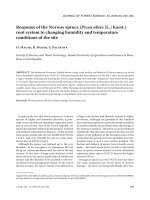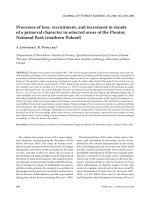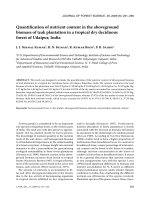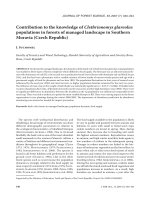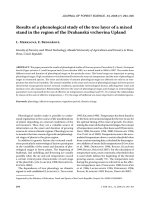Báo cáo lâm nghiệp: "Estimation of the biomass stock of trees in Sweden: comparison of biomass equations and age-dependent biomass expansion factors" ppsx
Bạn đang xem bản rút gọn của tài liệu. Xem và tải ngay bản đầy đủ của tài liệu tại đây (477.39 KB, 7 trang )
845
Ann. For. Sci. 62 (2005) 845–851
© INRA, EDP Sciences, 2005
DOI: 10.1051/forest:2005075
Original article
Estimation of the biomass stock of trees in Sweden: comparison
of biomass equations and age-dependent biomass expansion factors
Anneli JALKANEN
a
, Raisa MÄKIPÄÄ
b
*, Göran STÅHL
c
, Aleksi LEHTONEN
b
, Hans PETERSSON
c
a
University of Helsinki, PO Box 27, 00014 University of Helsinki, Finland
b
Finnish Forest Research Institute, Unioninkatu 40 A, 00170 Helsinki, Finland
c
Swedish University of Agricultural Sciences, Forest Resource Management and Geomatics, 901 83 Umeå, Sweden
(Received 13 April 2004; accepted 14 March 2005)
Abstract – Differences and uncertainties of alternative methods applicable to estimation of biomass in national greenhouse gas inventories are
evaluated. The alternative methods employed to obtain biomass estimates of trees are (1) aggregated stand-level volume estimates multiplied
by biomass expansion factors (BEF), and (2) biomass equations applied to tree-wise data of a national forest inventory. In comparison to the
reference value obtained using tree-wise biomass equations, the age-dependent BEFs for the whole of Sweden resulted in a 6.7% lower
aboveground biomass estimate. The estimates were the closest for conifer-dominated forests in central Sweden, and the largest discrepancies
were for spruce in southern Sweden. This result indicates that these age-dependent BEFs cannot be applied to conditions where stand
development deviates from the conditions under which the BEFs were developed. The degree of uncertainty in both methods was highest in the
young age-classes. At the regional level, the relative standard errors of the BEF-based biomass estimates were in the range of 4–13%.
biomass function / carbon stock of trees / forest inventory / greenhouse gas inventory / uncertainty
Résumé – Estimation de la biomasse sur pied en Suède : comparaison des équations de biomasses avec les facteurs d’expansion de la
biomasse (BEF) liés à l’âge. Nous avons évalué les différences et les incertitudes des méthodes alternatives d’estimation utilisable dans les
inventaires nationaux de GES. Ces méthodes sont (1) la multiplication des estimations du volume au niveau des peuplements avec les facteurs
d’expansion de la biomasse (BEF) et (2) l’application des équations de biomasses sur les données par arbres de l’IFN. La méthode des BEF a
donné, pour la forêt suédoise, une estimation de la biomasse inférieure de 6,7 % par rapport à la méthode de référence (2). Les différences entre
estimations étaient minimales dans les forêts de conifères du centre du pays et maximales dans les forêts d’épicéas du sud. Cela indiquerait que
les BEF liés à l’âge ne sont pas applicables dans des conditions s’éloignant du développement des peuplements boréaux. Le degré d’incertitude
était le plus élevé pour les classes d’âge jeunes. Au niveau régional, l’erreur relative standard des estimations se basant sur les BEF se situait
entre 4 et 13 %.
équation de biomasses / stock de carbone sur pied / inventaire forestier / inventaire des gaz à effet de serre / degré d’incertitude
1. INTRODUCTION
Estimation of the biomass and carbon stock of trees has
gained importance as a result of the Climate Convention and
the Kyoto Protocol. Extraction and storage of excess carbon
from the atmosphere into the forests is being considered as one
of the mechanisms for mitigation of climate change. Currently,
the methods used for calculating the biomass and carbon stock
of trees are imprecise and, in general, they lack estimation of
the degree of uncertainty as suggested by the Intergovernmen-
tal Panel on Climate Change (IPCC) good practice guidance
[5]. Information on the major uncertainties involved in the cal-
culations of forest carbon sinks is needed in the negotiations
of the Climate Convention. Furthermore, analysis of the
sources of error and identification of the key sources as well as
quantification of the overall level of uncertainty of forest car-
bon inventories will aid in prioritizing efforts to develop the
inventories.
In general, estimates of forest carbon stock and stock
changes are obtained by calculations based of growing stock
and net increment with the aid of simple conversion factors [7,
8, 12, 20, 21]. Quantitative uncertainty estimates (in terms of
relative standard error [RSE]) of the volume of growing stock
are provided by the national forest inventories (NFIs), and the
sampling errors reported are known to be less than 1% in several
European countries [10]. In addition to this sampling error, cal-
culation of the biomass stock of trees by applying volume equa-
tions and BEFs introduces additional sources of error to the
overall uncertainty of biomass estimates. In general, model
errors involved in the forest inventories are not accounted for
and quantitative uncertainties of the applied conversion and
* Corresponding author:
Article published by EDP Sciences and available at or />846 A. Jalkanen et al.
expansion factors are not known or are assumed to be large [5].
Conversion from stem volumes into whole-tree biomass is one
of the notable sources of error in forest carbon inventories [18].
Since most of the currently applied BEFs are not based on
regionally representative biomass sampling, they are likely to
give biased biomass estimates as a result.
Attempts have already been made to quantify and reduce the
uncertainties involved in BEFs by developing uncertainty esti-
mation and by taking into account the variation in the allometry
of trees. Since allometry varies according to size of the trees,
the variation in the BEFs can be related to dimensions of single
trees, or stand-level parameters such as dimensions of the
median tree of a stand, merchantable stem volume or stand age
[2, 6, 11, 19]. These BEFs should result in more accurate bio-
mass estimates than constant BEFs, since they account for var-
iation in the allometry of trees according to stand development.
Moreover, age-dependent BEFs are able to take into account
changes in the age-class distributions of growing stock. The
effect of average forest age structure on productivity at the
national level was also studied by Milne and Van Oijen [15].
Regional biomass estimates can also be calculated by applying
biomass equations [13, 14, 23] when treewise data of forest
inventories are available. This approach should provide accu-
rate estimates of the biomass of trees as far as the biomass equa-
tions are based on regionally representative sampling.
A high degree of inconsistency in carbon stock inventories
both in methods and in applied conversion factors across coun-
tries is often observed (e.g. [12, 21]). According to the IPCC
good practice guidance, use of simple conversion factors is rec-
ommended for Tier 1 inventories (Tier 1 indicates the lowest
level of reliability and data needs of inventory) [5]. In the higher
tiers, more specific BEFs and allometric equations should be
used. However, differences in biomass and carbon estimates
and their uncertainties resulting from the use of different meth-
ods are very rarely evaluated, with few exceptions like Van
Camp et al. [22].
In the present study, we evaluated differences in the biomass
estimates and their uncertainties resulting from the use of var-
ious methods applied to forest biomass and carbon stock assess-
ments at the regional and national levels. The objective was to
compare three methods applicable for estimating regional and
national biomass stocks of trees. Biomass stock was calculated
(1) with the aid of currently applied constant biomass expan-
sion factors (BEFs), (2) by applying age-dependent BEFs
developed for boreal forests in Finland [11] and (3) with bio-
mass equations [14] applied directly to treewise data of Swed-
ish NFI sample plots. The first two methods convert the stem
volume estimates to biomass, and the third method is based on
the aggregation of tree biomasses that are estimated from the
tree-wise dimensions measured in the NFI sample plots.
2. MATERIALS AND METHODS
2.1. Data from the Swedish National Forest Inventory
Data from the Swedish NFI (1997–2001), with the Swedish defi-
nition for forest land, were used in the calculations of this study [17].
The data were divided between four regions: Norra Norrland, Södra
Norrland, Svealand and Götaland (Fig. 1). The climatic conditions as
well as the average stem volume and species composition of forests
vary between these regions. Within each region, the sample plots were
further classified into pine-, spruce- or birch-dominated and mixed for-
ests. A stand dominated by a species is defined as one in which pine,
spruce or birch constitutes at least 70% of the basal area. Pine-domi-
nated forests with small volumes are characteristically found in the
north, whereas in the south stands are spruce-dominated and have high
stem volumes. Mixed forests, which formed about one third of the
sample plots, were not included in the calculations, since the division
of volume between tree species within plots could not be taken into
account in the calculations.
The Swedish NFI is organized as a systematic sample of temporary
and permanent sample plots that annually covers the entire country
[17]. In this design, an area-based ratio estimator is used to obtain the
sampling error of the estimates. For this, special weights are used to
combine sampling errors of estimates based on mean data from more
than one year of inventory and to combine sampling errors from tem-
porary and permanent sample plots.
2.2. Application of biomass and volume equations
The biomass for the tree fractions (stem wood, stem bark, branches
and needles) was estimated by applying biomass equations [14] to the
measured dimension (DBH) of sampled trees of the Swedish NFI [17].
Separate biomass functions were used for the tree species Scots pine
(Pinus sylvestris), Norway spruce (Picea abies) and birch (Betula pen-
dula and B. pubescens). These species constitute more than 90% of
Figure1. Location of the four study regions in Sweden, and the divi-
sion of the studied sample plots into pine-, spruce- and birch-domi-
nated and mixed forests.
Biomass estimation in large scale inventories 847
the standing stock [1]. The biomass equations for birch were applied
to the remaining broad-leaved species such as aspen and alder. Only
tree species and diameter at breast height (DBH) were used as inde-
pendent variables in the biomass equations. To estimate the volume
of the growing stock that was used in the calculation with BEFs,
Näslund’s volume equations [16] were applied to the treewise data of
the NFI.
2.3. Application of constant BEFs
The BEFs were used to calculate the total aboveground biomass of
trees based on the stem volume estimates, i.e.
W = BEF × V,(1)
where W is the aboveground tree biomass (dry weight, Mg), BEF the
biomass expansion factor Mg m
–3
and V the stem volume (m
3
). Con-
stant BEFs of 0.52 for Scots pine, 0.62 for Norway spruce and 0.64
for broad-leaved stands were applied in this study. These BEFs for
aboveground biomass were derived from the National Inventory
Report of Sweden [3]. Thus, they are consistent with the latest green-
house gas reporting from Sweden, but they refer only to aboveground
biomass.
2.4. Application of age-dependent BEFs
The tree species-specific age-dependent BEFs used in this study are
based on those of Lehtonen et al. [11], where the BEF B(t) is defined
as follows,
,(2)
B(t) being the BEF for the aboveground biomass (Mg m
–3
) and t the
stand age (years), while a and b are parameters (Eq. (2), Tab. I). These
age-dependent BEFs (Fig. 2) were used to convert growing stock to
the aboveground biomass of trees according to Eq. (1), but now by age-
classes. The stand age-classes used were 11–20, 21–30, 31–40, 41–
60, 61–80, 81–100, 101–120, 121–140 and over 141 years.
2.5. Different approaches to estimate biomass
The aboveground biomass of trees was calculated in three different
ways. In one, the biomass equations [14] were directly applied to tree-
wise data of the NFI sample plots. In another, the stem volume equa-
tions were used to calculate the volume of the growing stock in the
NFI sample plots, and the volume of the growing stock was converted
to biomass estimates with the constant BEFs. In third method, the stem
volumes were estimated as in the second method and the volume esti-
mates were then converted to biomass by multiplying with the BEFs
of the respective age-classes.
2.6. Uncertainty for biomass estimates of standing
stock
First, we evaluated the reliability of the biomass estimates in terms
of differences between the estimates obtained with alternative meth-
ods. The biomass estimates calculated with Marklund’s allometric
equations are considered to be the most realistic reference values for
the biomass of trees in Sweden. In the present study, we showed the
differences between the BEF-based estimates and the biomass esti-
mate calculated with Marklund’s equations according to age-classes
and regions.
Second, we evaluated the differences between methods in terms of
the relative standard errors (RSE) of the biomass estimates. Since the
biomass equations were directly applied to treewise data of the NFI
sample plots, the components of the errors accounted for are the sam-
pling and biomass model errors (assumed to be small). In the BEF-
based method, the sampling error in the volume estimate and error of
the BEFs are accounted for. Here, the sampling error for the stem vol-
ume of permanent sample plots by age-classes was combined with the
error of the BEFs [11] to obtain the RSE of the tree biomass stock in
a given age-class using the following equation
,(3)
where r
stock,i
is the relative standard error of the biomass stock in age-
class i, r
V,i
the relative standard error of the estimate for total stem vol-
ume in age-class i, and r
bef,i
is relative standard error of the BEF in
age-class i.
Thereafter, the relative standard error of the overall biomass esti-
mate of trees was calculated as
,
(4)
where r
tot
is relative standard error of the total biomass (sum of all age-
classes), W
i
the biomass stock in age-class i and r
stock,i
is the relative
standard error of the biomass stock in age-class i. These error propa-
gation equations are applicable to estimation of the overall uncertainty
of a product of several quantities (Eq. (3)) and the overall uncertainty
of the summed quantities (Eq. (4)) [5].
Table I. Parameter values for Eq. (2) according to study by Lehtonen
et al. [11]. These BEF equations are used for Scots pine, Norway
spruce and broad-leaved (for birch) stands to convert stem volume
estimates to total aboveground biomass. BEF is Mg m
–3
and the
independent variable stand age (t) is in years.
Parameter a Standard
error
b Standard
error
Mean
of response
Scots pine 0.5436 0.0012 0.0193 0.0019 0.5548
Norway spruce 0.5734 0.0049 0.1272 0.0092 0.6358
Broad-leaved 0.5616 0.0041 –0.0179 0.0056 0.5490
100
)(
t
ebatB
−
×+=
Figure 2. Age-dependent BEFs for Scots pine, Norway spruce and
birch [11]. The estimates are calculated for the mean of the respective
age-class, i.e. mean is 15, 25, 35, 50, 70, 90, 110, 130 or 150 years.
r
stock,i
r
V,i
2
r
bef,i
2
+=
r
tot
r
stock,1
W
1
×()
2
r
stock,2
W
2
×()
2
…r
stock,n
W
n
×()
2
++
W
1
W
2
…W
n
++
-=
848 A. Jalkanen et al.
3. RESULTS
3.1. Biomass comparisons
At the national level, the highest estimate for the total
aboveground biomass of trees was based on the treewise NFI
data and biomass equations, totalling 1195.6 million Mg
(Tab. II). The age-dependent BEFs gave the smallest estimate
for the total biomass, being 1115.0 million Mg (6.7% smaller),
whereas the constant BEFs resulted in a biomass estimate of
1134.1 million Mg.
The biomass estimates based on Marklund’s equations [14]
were an average of 4–30% higher than the estimates calculated
with age-dependent BEFs (Tab. II and Fig. 3). For pine, the dif-
ferences in the estimates obtained with the various methods
were generally smaller than for the other tree species (Fig. 4).
The most divergent estimates for biomass were obtained for
spruce in the Svealand and Götaland regions. In Svealand, the
use of BEFs for Norway spruce in young stands resulted in
lower, and in mature stands, higher biomass estimates than did
use of the biomass equations. In Götaland, BEFs resulted in bio-
mass estimate of mature Norway spruce stands 30% higher than
that obtained with the Marklund’s biomass equations. In com-
parison to Marklund’s estimates, the BEF-based biomass esti-
mate for birch was lower in the northern part of Sweden, while
in the southern part the BEF-based biomass estimate for spruce
was higher.
Table II. Relative standard errors (RSE) of biomass estimates and of the differences in biomass estimates according to dominant tree species
in four different regions of Sweden. Calculations based on Marklund’s biomass equations, nonage-dependent Swedish biomass expansion fac-
tors (BEF) and age-dependent BEFs.
Region Stand type RSE for
biomass estimates
Biomass estimate of trees Difference between biomass estimates
(Marklund – BEF)
Marklund Age-dep.
BEF
Marklund Nonage- dep.
BEF
Age-dep.
BEF
Marklund –
Nonage-dep. BEF
Marklund –
Age-dep. BEF
% % Mill. t Mill. t Mill. t Mill. t % Mill. t %
N Norrland Pine 3.0 4.4 157.7 139.9 146.4 17.9 11.3 11.3 7.7
Spruce 6.5 6.7 85.8 75.1 75.3 10.7 12.4 10.5 14.0
Birch 8.3 11.0 13.9 12.6 10.7 1.3 9.5 3.2 29.5
Mixed (102.6)
S Norrland Pine 3.4 4.7 121.3 111.5 117.1 9.8 8.1 4.3 3.6
Spruce 3.5 5.2 177.4 169.2 133.3 8.2 4.6 44.1 3.7
Birch 10.2 12.9 8.2 7.6 6.5 0.6 7.5 1.7 26.4
Mixed (125.2)
Svealand Pine 2.7 4.2 141.9 129.5 120.6 12.4 8.8 21.3 4.6
Spruce 2.9 4.4 145.0 146.7 152.6 –1.7 –1.2 –7.6 –3.9
Birch 8.4 11.2 8.7 9.3 7.9 –0.6 –6.8 0.8 11.5
Mixed (136.3)
Götaland Pine 2.9 4.4 102.8 91.8 96.3 11.0 10.7 6.6 6.4
Spruce 2.3 4.2 219.3 226.7 236.3 –7.4 –3.4 –17.0 –7.2
Birch 6.4 9.2 13.4 14.1 11.9 –0.7 –4.7 1.5 13.5
Mixed (162.5)
Sweden all * 1195.6 1134.1 1115.0 61.6 5.1 80.7 6.7
* Excluding mixed stands.
Figure 3. Total stem volume (m
3
ha
–1
) and aboveground biomass
(Mg ha
–1
) of (a) Scots pine and (b) Norway spruce according to stand
age in Södra Norrland estimated with Marklund’s allometric equa-
tions [14] and age-dependent biomass expansion factors [11].
(a)
(b)
Biomass estimation in large scale inventories 849
In absolute terms, the differences between biomass esti-
mates appeared to peak in the intermediate forest age-classes,
whereas in the youngest and oldest age-classes the estimates by
the various methods agreed well (Fig. 4). However, as illus-
trated by an example for spruce, the differences in relative terms
between the estimates obtained with various methods were also
large among the youngest age-classes (Fig. 5).
3.2. Error comparisons
The errors associated with the biomass calculations at the
tree level were compared with the errors produced by the cal-
culations based on stand-level volume estimates and age-
dependent BEFs. In general, the relative standard errors (RSEs)
for the BEF-based estimates were slightly larger than those
based on Marklund’s models, as shown in Södra Norrland
(Fig. 6). The RSEs for all estimates ranged mostly from 10%
to 20%.
For both of the evaluated methods, the biomass estimates of
the intermediate age-classes of forests were more accurate than
those of the youngest and oldest age-classes. Of the tree species,
the errors were smallest for pine and largest for birch. For birch,
the dependency of precision on stand age was the most pro-
nounced and the largest error was found in the oldest age-
classes, in contrast to spruce for which the errors were in the
youngest age-classes. The errors for pine were not age-depend-
ent. To summarize, the errors did not differ greatly among
regions, but did among tree species.
Figure 4. Difference between biomass estimates in the various age classes calculated with Marklund’s equations, and those based on age-depen-
dent BEFs in four regions in Sweden.
Figure 5. Relative difference in biomass estimates for spruce in the
various regions, Marklund’s estimate minus BEF-based estimate (%
of Marklund’s estimate).
850 A. Jalkanen et al.
4. DISCUSSION
Regional and national biomass estimates have been and,
according to IPCC good practice guidance, will continue to be
calculated based on volume estimates with the aid of biomass
expansion factors (BEFs) [5, 12]. However, the errors in
national carbon assessment introduced by the applied BEFs
may be large and unknown. Thus, the overall uncertainties
resulting from the various calculation methods applicable to
national assessment of the carbon stock of trees may differ con-
siderably between countries. Our results show that the above-
ground biomass stock of trees in Sweden estimated with the aid
of the currently applied constant tree species-specific BEFs was
5% lower than the estimate obtained by applying Marklund’s
biomass equations directly to treewise data of the NFI. Thus,
the currently applied constant BEFs resulted in relatively con-
sistent biomass estimates with the other more detailed methods
tested in this study. The BEFs previously applied in inventories
performed in Sweden have, however, varied considerably from
year to year [3, 4, 12, 21], with some resulting in biomass esti-
mates as much as 20% higher than those obtained with the more
detailed methods used here.
In general, the age-dependent BEFs [11] and use of biomass
equations [14] resulted in relatively close biomass estimates.
At the national level the positive and negative differences were
balanced, and the overall difference in aboveground biomass
between treewise estimates and age-dependent BEFs was sur-
prisingly low, only 6.7% (excluding mixed stands).
The differences between biomass estimated with the age-
dependent BEFs and biomass equations were largest for Nor-
way spruce stands in southern Sweden, where age-dependent
BEFs of 60-100-year-old Norway spruce stands resulted in bio-
mass estimates 30% higher than were obtained with the bio-
mass equations. This indicates that these age-dependent BEFs
cannot be applied to conditions under which stand development
deviates from that encountered in the boreal forests of Finland.
Under the more favourable conditions found in southern Swe-
den, the mean stem volumes of each age-class are evidently
higher than those found under boreal conditions. Furthermore,
the stem volumes of older Norway spruce stands in southern
Sweden, which can exceed an average of 250 m
3
ha
–1
, fall out-
side the range of data used in formulation of these BEFs [11].
In Sweden, as well as in the other European countries, con-
stant BEFs without quantitative uncertainty estimates have
been applied in the reporting of carbon stock of trees to the
UNFCCC [12]. Consequently, the overall error occurring with
use of these constant BEFs cannot be assessed. The age-
dependent BEFs applied here were based on regionally repre-
sentative sampling, account for variation in stand-level bio-
mass allocation according to stand development and included
error estimates [11]. The error estimates of the age-dependent
BEFs applied in this study included both model and sampling
errors, resulting in RSEs of the biomass estimate in the range
of 4–13% at the regional level, depending on tree species. The
errors in biomass estimates obtained with allometric equations
ranged from 2% to 10%, and only sampling errors were
accounted for.
Both of the applied methods resulted in the highest degree
of uncertainty of the biomass estimate in the young age-classes.
The uncertainty of the biomass estimate calculated with the
age-dependent BEFs was highest in the youngest age-classes
due to the high degree of uncertainty of the BEFs in young
stands. Since the age-dependent BEFs [11] were formulated
based on the volume equations [9] and biomass equations [14],
the model errors of both equations were included in the error
of BEF.
Figure 6. Estimated relative standard errors (RSEs) of the biomass
estimates by dominant tree species in Södra Norrland. M = error of
the biomass estimate calculated with the Marklund’s biomass equa-
tions (sampling error only accounted for) and BEF = error estimate
including sampling error of the volume estimate and error of the BEF.
Biomass estimation in large scale inventories 851
The uncertainties of the biomass estimates were, in general,
highest for birch stands, intermediate for Norway spruce and
lowest for Scots pine. The uncertainty in the biomass estimates
of birch was high, since the number of birch stands was low in
both the material used for formulation of the BEFs, and in the
Swedish data on which the BEFs were applied, especially in the
north.
The IPCC good practice guidance [5] recommends the use
of BEFs and provides default values of BEFs for use in the Tier 1
method. Our results indicate that the applicability of the avail-
able BEFs needs to be carefully evaluated, especially for the
possible presence of bias, before they can be used in the national
inventories. Furthermore, it is evident that the time series of the
inventory, i.e. the biomass estimates of the earlier inventories,
needs to be recalculated when the BEFs are updated.
Acknowledgements: The study was funded by the Finnish Forest
Research Institute, the Swedish University of Agriculture and Forestry
and the CarboInvent consortium (project number EVK2-CT-2002-
00157) of the European Commission under the 5th Framework Pro-
gramme.
REFERENCES
[1] Anonymous, Forestry statistics 2002, Official Statistics of Sweden,
Swedish University of Agricultural Sciences, Umeå, 2002, pp. 1–
107.
[2] Brown S., Measuring carbon in forests: current status and future
challenges, Environ. Pollut. 116 (2002) 363–372.
[3] Feldhusen K., Hammarskjöld G., Mjureke D., Pettersson S.,
Sandberg T., Staaf H., Svensson U., Österberg K., Sweden’s Natio-
nal Inventory Report 2004, Submitted under the United Nations
Framework Convention on Climate Change, Swedish Environmen-
tal Protection Agency, 2004.
[4] Fink S., Feldhusen K., Hammarskjöld G., Pettersson S., Staaf H.,
Österberg K., Adolfsson R., Ivarsson A., Lidén M., Petersson H.,
Sweden’s National Inventory Report 2003, Submitted under the
United Nations Convention on Climate Change, Swedish Environ-
mental Protection Agency, 2003.
[5] IPCC, Good practice guidance for land use, land-use change and
forestry, IPCC National Greenhouse Gas Inventories Programme,
2004.
[6] Jenkins J.C., Chojnacky D.C., Heath L.S., Birdsey R., National-
scale biomass estimators for United States tree species, For. Sci. 49
(2003) 12–35.
[7] Kauppi P.E., Mielikäinen K., Kuusela K., Biomass and carbon bud-
get of European forests, 1971 to 1990, Science 256 (1992) 70–74.
[8] Kauppi P.E., Tomppo E., Ferm A., C and N storage in living trees
within Finland since 1950s, Plant Soil 168–169 (1995) 633–638.
[9] Laasasenaho J., Taper curve and volume functions for pine, spruce
and birch, Commun. Inst. For. Fenn. 108 (1982) 1–74.
[10] Laitat E., Karjalainen T., Loustau D., Lindner M., Towards an inte-
grated scientific approach for carbon accounting in forestry, Bio-
technol. Agron. Soc. Environ. 4 (2000) 241–251.
[11] Lehtonen A., Mäkipää R., Heikkinen J., Sievänen R., Liski J., Bio-
mass expansion factors (BEF) for Scots pine, Norway spruce and
birch according to stand age for boreal forests, For. Ecol. Manage.
188 (2004) 211–224.
[12] Löwe H., Seufert G., Raes F., Comparison of methods used within
member states for estimating CO
2
emissions and sinks according to
UNFCCC and EU monitoring mechanism: forest and other wooded
land, Biotechnol. Agron. Soc. Environ. 4 (2000) 315–319.
[13] Marklund L.G., Biomass functions for Norway spruce (Picea abies
(L.) Karst.) in Sweden, Swedish University of Agricultural Scien-
ces, Dept. of Forest Survey, 1987, pp. 1–127.
[14] Marklund L.G., Biomassafunktioner för tall, gran och björk i Sve-
rige, Sveriges lantbruksuniversitet, Rapporter-Skog 45 (1988) 1–73.
[15] Milne R., van Oijen M., A comparison of two modelling studies of
environmental effects on forest carbon stocks across Europe, Ann.
For. Sci. 62 (2005) 911–923.
[16] Näslund M., Funktioner och tabeller för kubering av stående träd.
Tall, gran och björk i södra Sverige samt i hela landet., Meddelande
från Statens Skogsförsöksanstalt 36 (1947) 1–81.
[17] Ranneby B., Cruse T., Hägglund B., Jonasson H., Swärd J., Design
a new national forest survey for Sweden, Stud. For. Suec. 177
(1987) 1–29.
[18] Schoene D., Assessing and reporting forest carbon stock changes
for FRA, UNFCCC and Kyoto Protocol: a concerted effort? in:
Luhtala A., Varjo J. (Eds.), Proceedings of FAO expert consultation
on global forest resource assessment 2002, Metsäntutkimuslaitok-
sen tiedonantoja, 2002, pp. 290–297.
[19] Schroeder P., Brown S., Mo J., Birdsey R., Cieszewski C., Biomass
estimation for temperate broadleaf forests of the United States
using inventory data, For. Sci. 43 (1997) 424–434.
[20] Tomppo E., National forest inventory in Finland and its role in esti-
mating the carbon balance of forests, Biotechnol. Agron. Soc. Envi-
ron. 4 (2000) 241–320.
[21] UN-ECE/FAO, Forest Resources of Europe, CIS, North America,
Australia, Japan and New Zealand (industrialized temperate/boreal
countries), UN-ECE/FAO Contribution to the Global Forest
Resources Assessment 2000, Main Report, United Nations, New
York and Geneva, 2000.
[22] Van Camp N., Vande Walle I., Mertens J., De Neve S., Samson R.,
Lust N., Lemeur R., Boeckx P., Lootens P., Beheydt D., Mestdagh
I., Sleutel S., Verbeeck H., Van Cleemput O., Hofman G., Carlier
L., Inventory-based carbon stock of Flemish forests: a comparison
of European biomass expansion factors, Ann. For. Sci. 61 (2004)
677–682.
[23] Wirth C., Schumacher J., Schulze E.D., Generic biomass functions
for Norway spruce in Central Europe – a meta-analysis approach
towards prediction and uncertainty estimation, Tree Physiol. 24
(2004) 121–139.





